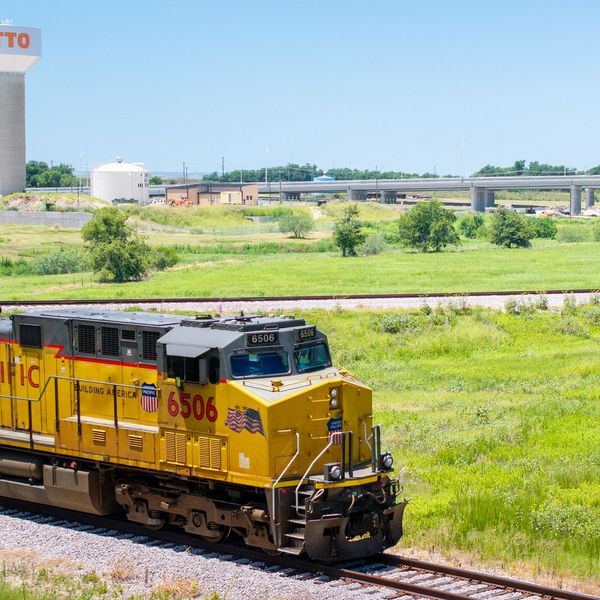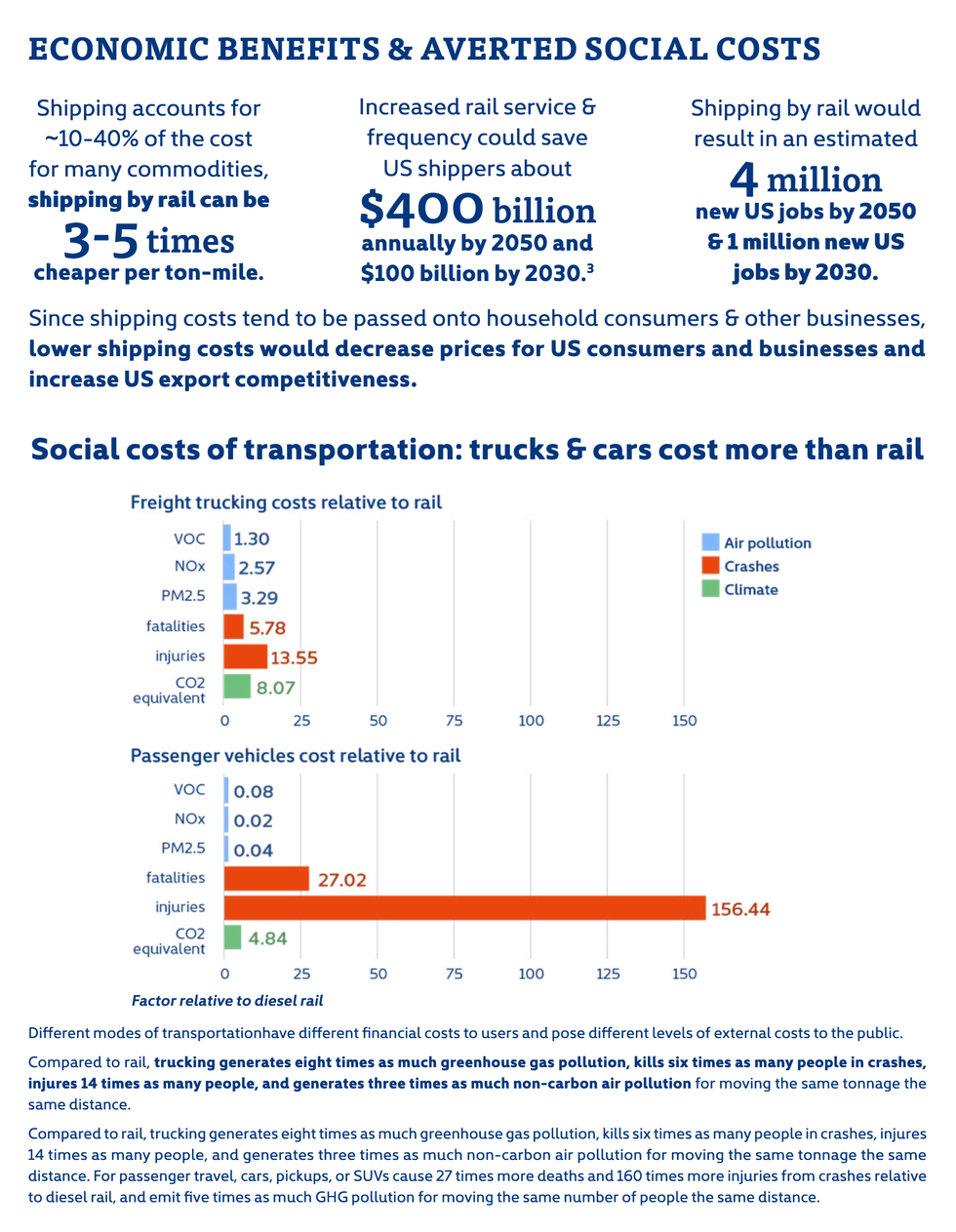
An Amtrak Pacific Surfliner train is pictured passing the Railroad Junctions of Los Angeles Union Station.
The Privatized US Rail System Is a Disaster. A New Report Makes Case for a Public Takeover
A transition to public ownership could create millions of new jobs, curb planet-warming emissions, protect public health, and slash shipping costs.
In recent years, the United States' rail system has been in the headlines for all the wrong reasons.
In East Palestine, Ohio, a Norfolk Southern train carrying hazardous materials wrecked, sparking a public health crisis and national outcry. More rail workers have been killed on the job in notoriously unsafe conditions. Train after train has derailed.
Such disasters have come as no surprise to rail workers on the frontlines, who have long warned that the corporate-dominated U.S. system is a threat to public safety, employees, and the climate.
But a new report argues it doesn't have to be that way—and envisions an alternative: a publicly owned rail system that saves money, creates jobs, protects workers and the public, and aids the badly needed transition to a green transportation system.
"The structure of the railroad industry in the United States constitutes a massive and ongoing missed opportunity," wrote Kira McDonald, a fellow at the Climate and Community Institute and the lead author of "From Margins to Growth: The Economic Case for a Public Rail System," an analysis published Tuesday by the Public Rail Now campaign and Railroad Workers United.
"Freight service is in decline, and passenger service lags enormously behind international peers," McDonald continued. "Long-term trends of decreased freight service, decreased market share, and decreased employment have accelerated in recent years, particularly with the advent of precision-scheduled railroading (PSR) across most Class 1 railroads. In many ways, these are predictable consequences of how the industry is structured: as a set of massive, largely underregulated, regional duopolies."
"Public operation predominates among the most successful and intensely used rail systems internationally."
Just a handful of private companies control the majority of the U.S. freight rail network, leaving large swaths of the country with access to just one or two privatized railroads. The heavily concentrated rail industry's model of maintaining "supernormal profits" and delivering for shareholders by slashing investment, McDonald wrote, runs directly counter to public priorities, including expanded passenger service.
Amtrak, the United States' passenger rail corporation, is managed as a for-profit company and "runs passenger service on tracks that are typically owned by the private Class 1 railroads," McDonald observed. While private railroads are by law required to give preferential treatment to Amtrak's passenger trains over freight, "this has rarely been enforced," leading to often terrible performance.
Bringing the U.S. rail system under public ownership, the new report argues, would be transformational, allowing for greater investment in passenger and freight rail and thus helping to shift away from costly and heavily polluting on-road transportation.
The report estimates that under an ambitious reform scenario that entails a publicly owned high-speed passenger rail network and other major developments, the U.S. by 2050 "could save up to $400 billion annually on shipping costs; avert over $190 billion annually in averted public health, environmental, and fiscal costs; create 180,000 new jobs in the railroad sector; and create up to four million other new jobs throughout the economy through indirect economic effects."
Transforming the U.S. rail system is almost certainly a "climate necessity," McDonald argued, noting that "current plans to decarbonize transportation within the U.S., particularly on a timeline consistent with even 2°C of warming, are extremely tenuous, to the point of implausibility."
Massively shifting passenger and freight transport to rail could help the U.S. avoid the "equivalent to 2% of the world's remaining carbon budget to maintain a 50% chance of staying within 1.5°C of warming, as of 2023," McDonald wrote.
While the report does not detail precisely how U.S. railroads should be brought under public ownership, it notes that "a comparative
analysis of railroad institutions and international practices indicate the promise of public ownership, particularly when paired with
integrated public operation."
"Public operation predominates among the most successful and intensely used rail systems internationally," pointing to Switzerland, South Korea, and Germany as examples of countries with rail systems that are largely owned by the public.
Tommy Carden, associate director of the Green Locomotive Project at Warehouse Workers for Justice, said in a statement that the new report "clearly demonstrates that under public ownership, working Americans would benefit enormously."
"Class 1 railroads are hoarding wealth that could be used to invest in and expand the rail industry," said Carden. "We must continue to advocate for the massive amounts of infrastructure that rail electrification will require while also pushing for the adoption of low-emission locomotives built by union workers as we continue to work towards achieving full rail electrification."
Eric Basir, a union steward with the Amalgamated Transit Union Local 308, said he has witnessed firsthand "how private ownership of railroads is responsible for the destruction of our environment and good union jobs."
"It will only worsen," Basir added, "until the people who live in this country have control and accountability powers over the railroads."
An Urgent Message From Our Co-Founder
Dear Common Dreams reader, The U.S. is on a fast track to authoritarianism like nothing I've ever seen. Meanwhile, corporate news outlets are utterly capitulating to Trump, twisting their coverage to avoid drawing his ire while lining up to stuff cash in his pockets. That's why I believe that Common Dreams is doing the best and most consequential reporting that we've ever done. Our small but mighty team is a progressive reporting powerhouse, covering the news every day that the corporate media never will. Our mission has always been simple: To inform. To inspire. And to ignite change for the common good. Now here's the key piece that I want all our readers to understand: None of this would be possible without your financial support. That's not just some fundraising cliche. It's the absolute and literal truth. We don't accept corporate advertising and never will. We don't have a paywall because we don't think people should be blocked from critical news based on their ability to pay. Everything we do is funded by the donations of readers like you. Will you donate now to help power the nonprofit, independent reporting of Common Dreams? Thank you for being a vital member of our community. Together, we can keep independent journalism alive when it’s needed most. - Craig Brown, Co-founder |
In recent years, the United States' rail system has been in the headlines for all the wrong reasons.
In East Palestine, Ohio, a Norfolk Southern train carrying hazardous materials wrecked, sparking a public health crisis and national outcry. More rail workers have been killed on the job in notoriously unsafe conditions. Train after train has derailed.
Such disasters have come as no surprise to rail workers on the frontlines, who have long warned that the corporate-dominated U.S. system is a threat to public safety, employees, and the climate.
But a new report argues it doesn't have to be that way—and envisions an alternative: a publicly owned rail system that saves money, creates jobs, protects workers and the public, and aids the badly needed transition to a green transportation system.
"The structure of the railroad industry in the United States constitutes a massive and ongoing missed opportunity," wrote Kira McDonald, a fellow at the Climate and Community Institute and the lead author of "From Margins to Growth: The Economic Case for a Public Rail System," an analysis published Tuesday by the Public Rail Now campaign and Railroad Workers United.
"Freight service is in decline, and passenger service lags enormously behind international peers," McDonald continued. "Long-term trends of decreased freight service, decreased market share, and decreased employment have accelerated in recent years, particularly with the advent of precision-scheduled railroading (PSR) across most Class 1 railroads. In many ways, these are predictable consequences of how the industry is structured: as a set of massive, largely underregulated, regional duopolies."
"Public operation predominates among the most successful and intensely used rail systems internationally."
Just a handful of private companies control the majority of the U.S. freight rail network, leaving large swaths of the country with access to just one or two privatized railroads. The heavily concentrated rail industry's model of maintaining "supernormal profits" and delivering for shareholders by slashing investment, McDonald wrote, runs directly counter to public priorities, including expanded passenger service.
Amtrak, the United States' passenger rail corporation, is managed as a for-profit company and "runs passenger service on tracks that are typically owned by the private Class 1 railroads," McDonald observed. While private railroads are by law required to give preferential treatment to Amtrak's passenger trains over freight, "this has rarely been enforced," leading to often terrible performance.
Bringing the U.S. rail system under public ownership, the new report argues, would be transformational, allowing for greater investment in passenger and freight rail and thus helping to shift away from costly and heavily polluting on-road transportation.
The report estimates that under an ambitious reform scenario that entails a publicly owned high-speed passenger rail network and other major developments, the U.S. by 2050 "could save up to $400 billion annually on shipping costs; avert over $190 billion annually in averted public health, environmental, and fiscal costs; create 180,000 new jobs in the railroad sector; and create up to four million other new jobs throughout the economy through indirect economic effects."
Transforming the U.S. rail system is almost certainly a "climate necessity," McDonald argued, noting that "current plans to decarbonize transportation within the U.S., particularly on a timeline consistent with even 2°C of warming, are extremely tenuous, to the point of implausibility."
Massively shifting passenger and freight transport to rail could help the U.S. avoid the "equivalent to 2% of the world's remaining carbon budget to maintain a 50% chance of staying within 1.5°C of warming, as of 2023," McDonald wrote.
While the report does not detail precisely how U.S. railroads should be brought under public ownership, it notes that "a comparative
analysis of railroad institutions and international practices indicate the promise of public ownership, particularly when paired with
integrated public operation."
"Public operation predominates among the most successful and intensely used rail systems internationally," pointing to Switzerland, South Korea, and Germany as examples of countries with rail systems that are largely owned by the public.
Tommy Carden, associate director of the Green Locomotive Project at Warehouse Workers for Justice, said in a statement that the new report "clearly demonstrates that under public ownership, working Americans would benefit enormously."
"Class 1 railroads are hoarding wealth that could be used to invest in and expand the rail industry," said Carden. "We must continue to advocate for the massive amounts of infrastructure that rail electrification will require while also pushing for the adoption of low-emission locomotives built by union workers as we continue to work towards achieving full rail electrification."
Eric Basir, a union steward with the Amalgamated Transit Union Local 308, said he has witnessed firsthand "how private ownership of railroads is responsible for the destruction of our environment and good union jobs."
"It will only worsen," Basir added, "until the people who live in this country have control and accountability powers over the railroads."
In recent years, the United States' rail system has been in the headlines for all the wrong reasons.
In East Palestine, Ohio, a Norfolk Southern train carrying hazardous materials wrecked, sparking a public health crisis and national outcry. More rail workers have been killed on the job in notoriously unsafe conditions. Train after train has derailed.
Such disasters have come as no surprise to rail workers on the frontlines, who have long warned that the corporate-dominated U.S. system is a threat to public safety, employees, and the climate.
But a new report argues it doesn't have to be that way—and envisions an alternative: a publicly owned rail system that saves money, creates jobs, protects workers and the public, and aids the badly needed transition to a green transportation system.
"The structure of the railroad industry in the United States constitutes a massive and ongoing missed opportunity," wrote Kira McDonald, a fellow at the Climate and Community Institute and the lead author of "From Margins to Growth: The Economic Case for a Public Rail System," an analysis published Tuesday by the Public Rail Now campaign and Railroad Workers United.
"Freight service is in decline, and passenger service lags enormously behind international peers," McDonald continued. "Long-term trends of decreased freight service, decreased market share, and decreased employment have accelerated in recent years, particularly with the advent of precision-scheduled railroading (PSR) across most Class 1 railroads. In many ways, these are predictable consequences of how the industry is structured: as a set of massive, largely underregulated, regional duopolies."
"Public operation predominates among the most successful and intensely used rail systems internationally."
Just a handful of private companies control the majority of the U.S. freight rail network, leaving large swaths of the country with access to just one or two privatized railroads. The heavily concentrated rail industry's model of maintaining "supernormal profits" and delivering for shareholders by slashing investment, McDonald wrote, runs directly counter to public priorities, including expanded passenger service.
Amtrak, the United States' passenger rail corporation, is managed as a for-profit company and "runs passenger service on tracks that are typically owned by the private Class 1 railroads," McDonald observed. While private railroads are by law required to give preferential treatment to Amtrak's passenger trains over freight, "this has rarely been enforced," leading to often terrible performance.
Bringing the U.S. rail system under public ownership, the new report argues, would be transformational, allowing for greater investment in passenger and freight rail and thus helping to shift away from costly and heavily polluting on-road transportation.
The report estimates that under an ambitious reform scenario that entails a publicly owned high-speed passenger rail network and other major developments, the U.S. by 2050 "could save up to $400 billion annually on shipping costs; avert over $190 billion annually in averted public health, environmental, and fiscal costs; create 180,000 new jobs in the railroad sector; and create up to four million other new jobs throughout the economy through indirect economic effects."
Transforming the U.S. rail system is almost certainly a "climate necessity," McDonald argued, noting that "current plans to decarbonize transportation within the U.S., particularly on a timeline consistent with even 2°C of warming, are extremely tenuous, to the point of implausibility."
Massively shifting passenger and freight transport to rail could help the U.S. avoid the "equivalent to 2% of the world's remaining carbon budget to maintain a 50% chance of staying within 1.5°C of warming, as of 2023," McDonald wrote.
While the report does not detail precisely how U.S. railroads should be brought under public ownership, it notes that "a comparative
analysis of railroad institutions and international practices indicate the promise of public ownership, particularly when paired with
integrated public operation."
"Public operation predominates among the most successful and intensely used rail systems internationally," pointing to Switzerland, South Korea, and Germany as examples of countries with rail systems that are largely owned by the public.
Tommy Carden, associate director of the Green Locomotive Project at Warehouse Workers for Justice, said in a statement that the new report "clearly demonstrates that under public ownership, working Americans would benefit enormously."
"Class 1 railroads are hoarding wealth that could be used to invest in and expand the rail industry," said Carden. "We must continue to advocate for the massive amounts of infrastructure that rail electrification will require while also pushing for the adoption of low-emission locomotives built by union workers as we continue to work towards achieving full rail electrification."
Eric Basir, a union steward with the Amalgamated Transit Union Local 308, said he has witnessed firsthand "how private ownership of railroads is responsible for the destruction of our environment and good union jobs."
"It will only worsen," Basir added, "until the people who live in this country have control and accountability powers over the railroads."


